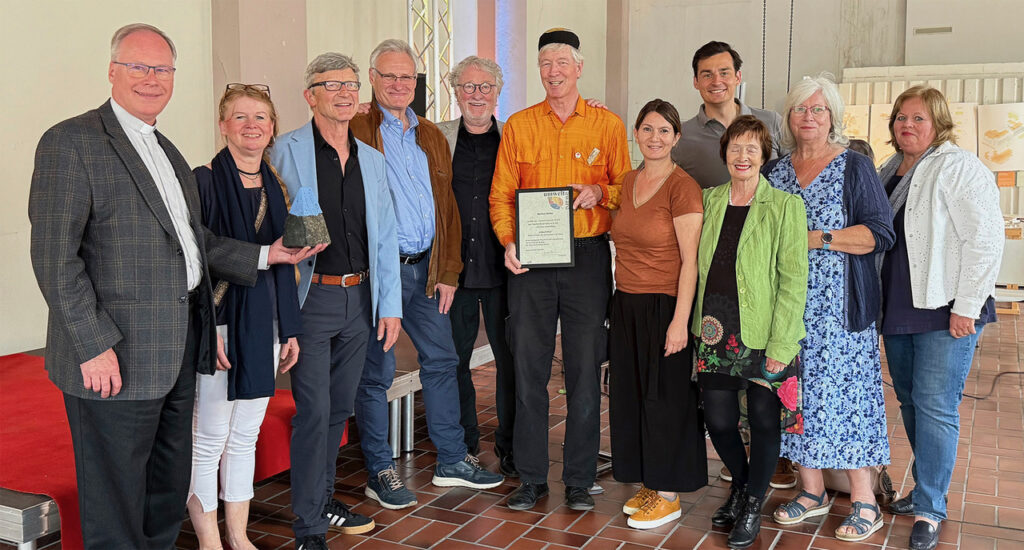On May 17, 2025, Markus Bollen won the 2024 Environmental Award from the Bergisch Gladbach City Association for Culture.
For his exhibition "Invisible" (2024-2025) at the Bergisch Gladbach Adult Education Center (VHS) and his diverse environmental initiatives, Markus Bollen received the 2024 Environmental Award from the Bergisch Gladbach City Association for Culture on May 17, 2025, at the Zukunftswerkstatt (Future Workshop) on the Zanders site. In his at first glance highly aesthetic images, he addresses profound environmental problems, such as over-fertilization of water bodies and the emergency fruiting of trees.
Photographing the invisible—which actually sounds like a contradiction—is what photographer Markus Bollen achieved in his 2024 exhibition at the adult education center. From November 2024 to January 2025, Markus Bollen presented works from the past 30 years. With this exhibition, the artist submitted the exhibition for the 2024 Environmental Award from the City Association of Culture. And the jury chose him as the winner because his work, in a unique way, inspires reflection on climate change and species extinction. Congratulations!
Photographing the invisible: This approach is once again remarkable as an artistic achievement in a world ... - that is virtually flooded with images, - in which nothing is immune to media and virtual reproduction, - in which the camera in mobile phones has become an everyday object for engaging with the environment, - in which producing and publishing images with apps has become an act of social exchange in the competition for lots of clicks and likes In this world, Markus Bollen turns the tables with his artistic work, using the medium for quiet and therefore all the more haunting messages that only become apparent at second glance.
Markus Bollen isn't interested in garish visual tones or cheap effects. He's not looking for a quick "like" – quite contrary to the zeitgeist. Rather, the photographer confronts viewers with an extremely subjective view of nature in his work… – in order to initially reveal a hidden aesthetic – to show beauty beyond the ordinary. Bollen, known for his panoramic photographs, uses a microscopic lens to reveal the spectacular in miniature in his exhibition, revealing the sensation of the hidden, drawing attention to colors, shapes, and patterns – seemingly aiming to inspire viewers with the beauty of nature.
Banal landscape and nature photography, that's the impression at first glance? Grandiose aesthetics, simply beautiful. Perhaps too beautiful? Yes, because there's more to it! Bollen enlightens viewers in his exhibition. He makes it clear what they see and why they see it! And this step—from observation to exposure—this step is what makes the exhibition so special.
He depicts a dense, delicate carpet of pollen on the surface of the Cadet Pond. Nature as a creator of art, the aesthetics of the organic! – Yet the object of observation is simultaneously a cry for help from nature. For the viewer sees nothing less than emergency fruiting, Bollen explains in his comments on the image: Due to the deteriorating environmental conditions, trees are producing increased amounts of seeds and pollen. A last – seemingly desperate – attempt to pass on genes.
The work "Blackbrook" depicts the explosive growth of green algae in a lake as a result of over-fertilization – viewers are confronted with the aesthetics of the lake's eutrophication. Bollen contrasts – so to speak – the beauty of the image with the horror of realization. He takes viewers out of their short-lived comfort zone of art appreciation and then confronts them with the radical effects of climate change. The educational flyers, which help to contextualize what they see, are part of the concept. And they are an important part.
By giving viewers the key to deciphering the artworks, Bollen makes them complicit. In this way, he enlightens, triggers thought processes, and perhaps inspires action. His images are a clever way into the minds of viewers, far more effective than the mere documentation of environmental disasters, which is aimed at generating short-term outrage.
This is supported by an exhibition of hornet and wasp nests. Bollen demonstrates how fragile yet inventive fauna is. He inspires admiration and awe, outlines cycles and ecology, and points to processes in nature that are millions of years old – processes that could be destroyed by humans in just a few decades. All of this requires a detailed and expertly grounded engagement with the object of observation on the part of the artist, which Markus Bollen readily delivers. He is not only a photographer, but also a beekeeper and active member of the "Blühendes GL" initiative. The initiative recently created a natural garden in front of the exhibition space, the adult education center.
He counters criticism and accusation in his artwork with his own actions. This makes his messages all the more compelling. With his work, photographer Markus Bollen responds to pressing issues of our time and takes a clear stance on the question of whether art should also be political.
He cleverly uses the means of photography, reducing its claim to precise documentation to absurdity, which – as mentioned – only enhances the impact of the images.
This is one of the statements made by a fellow artist, which Bollen cites in connection with his exhibition: "That which I cannot see is of infinitely greater importance than that which I can see," as the American photographer Duane Michels put it. Markus Bollen impressively implements this approach with the exhibition "Invisible."
It's a quiet, silent death, a hidden drama, that's happening out there in nature. And therefore, clever ways are needed to point to the need and the imperative to act. A claim that Markus Bollen masterfully realizes with his works at a high artistic level. Art and message go hand in hand – which is why the jury is awarding him the 2024 Environmental Award.
Author NN, presented by Harald Mohr
